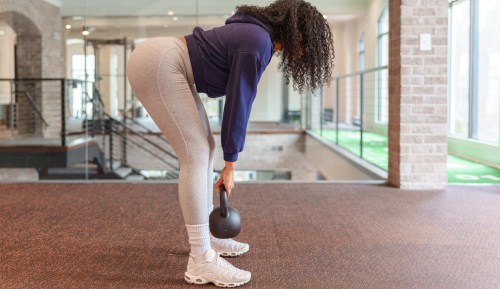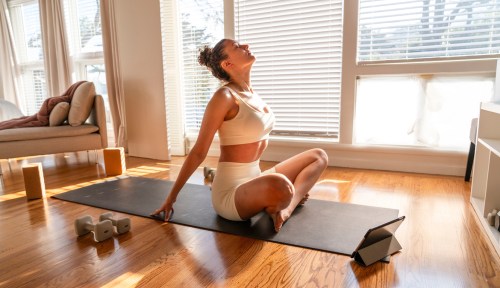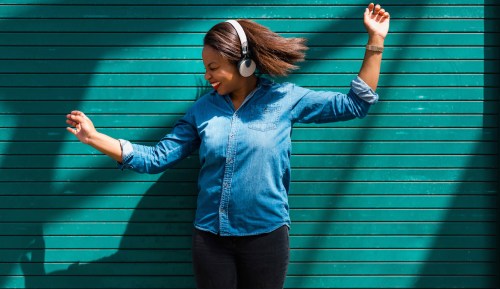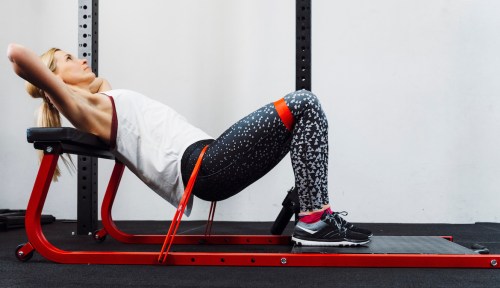Leg day in the gym would not be complete without sets of Romanian deadlifts for your glutes. All it takes is lowering a weight (like a dumbbell or barbell) from hip height toward the ground, while keeping your knees bent and the weight close to your body as you bend over, then driving your hips forward to stand back up. This one exercise—commonly known as RDLs—engages nearly the entire back side of your body, with a special emphasis on your hamstrings and glutes.
Experts in This Article
national lead trainer, Planet Fitness
But there may be a problem: What if you’re not actually feeling it in those places? You could be experiencing back pain by overcompensating with the incorrect muscles, or you could be plateauing with the amount of weight you’re able to lift.
Here are a few things to keep in mind if you want your Romanian deadlifts to feel stronger and less awkward.
Focus on the hinge motion
There’s a lot to think about when it comes to RDL form. For starters, this move is a hinge motion, not a squat. So to do it correctly, you really have to push your butt back behind you.
“You wanna think of it like your hips are the hinge to a gate,” as Teddy Savage, national lead trainer at Planet Fitness, describes it. “Your backside, your buttocks is important in this movement. It’s the primary mover, and you wanna think of it like your closing a car door with your butt.”
Use your mind
Another key is actively engaging the right muscles with a “mind-muscle connection,” as Savage says. “In your mind you should be thinking, I’m moving this weight with my glutes and hamstrings; I’m not moving it with my back muscles.”
Forging that mind-body connection can be tricky. One thing that can help is to activate the muscles before they actually do the work of lifting. In other words, squeeze your glutes and hamstrings when you are in the hinge forward position, before you bring your upper body upright.
Stretch and mobilize
Mobility is all about enabling joints to reach their full range of motion, while flexibility allows muscles to lengthen to their longest point. To get the most out of any exercise, a mobilized joint and flexible muscle are paramount.
For an RDL, stiff hips and tight hamstrings—which are common side effects of sitting in one position for long periods of time—can impact the range of motion you can access, and therefore the amount of weight you can lift.
“If you feel like you’re not really progressing, it may be because you’re not achieving your fullest range of motion,” Savage says.
He suggests stretching both before and after working out, and incorporating stretches like good mornings that mimic the hinging motion.
Start light
If you find yourself plateauing in your RDLs, you might actually be lifting too heavy. Weights that cause you to compromise on form impact your ability to activate the correct muscles, which means you might not be getting the most out of the exercise.
“Always start light and focus on form and mechanics,” Savage says. “As you feel comfortable with being able to move your body through its full range of motion, start adding weight incrementally.”
Do complementary isolated movements
Since the RDL is a compound exercise, one way to improve your power is to work on the individual muscle components that go into executing the move.
“Do exercises that target those muscles independently,” Savage says. “So we know that hamstrings are really important to RDLs—do hamstringing curls to just strengthen that muscle by itself. We know glutes are one of the prime movers of this motion, so do a couple of glute kickbacks.”
Try different tools
If you’re only using dumbbells, Savage suggests switching up the kind of resistance you’re using, which can provide a new challenge to the muscles.
“Making sure that you use different modalities to strengthen those muscles in different ways starts firing off those stabilizers and you’ll be able to increase your progress,” Savage says.
Resistance bands, barbells, cables, or kettlebells are all great dumbbell alternatives.
Pay attention to back strain and pain
Pushing through pain is not the answer, especially if that pain is originating in your back. It could indicate you’re doing the move wrong, and therefore not engaging the correct muscles—and subsequently not strengthening those muscles.
“If you’re feeling it somewhere where you shouldn’t be, you wanna stop and correct form and technique,” Savage says. “Having your back stay out of it as much as possible starts even before you go into the hinging motion, because you wanna keep a good neutral spine at all times. That means you wanna have your chest nice and pronounced, roll your shoulders down and back, and then engage your lats—which are the big muscles right under your armpit—and the lower lumbar muscles. Those muscles stay engaged throughout the movement.”
Go at your own pace
RDLs might sound intimidating, but Savage is confident it’s a move that anyone from a beginner to an expert can execute and use to develop strength. Approach the exercise with patience and curiosity, and know that progressing at your own pace is just fine.
“You don’t have to judge yourself for being a beginner at it. Have fun taking your time and enjoying the progress and understanding how you get better one step at a time,” Savage says. “That’s important not only for being proficient at RDLs, but all exercises. Understand that it’s okay to begin at something and progressively work your way up with patience.”
Sign Up for Our Daily Newsletter
Get all the latest in wellness, trends, food, fitness, beauty, and more delivered right to your inbox.
Got it, you've been added to our email list.











